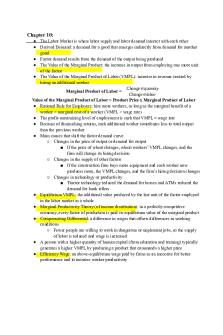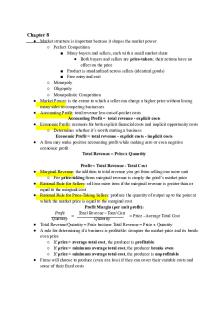Micro Econ Chapter 7 Lecture Notes PDF

| Title | Micro Econ Chapter 7 Lecture Notes |
|---|---|
| Course | Intro To Microeconomics |
| Institution | Indiana University - Purdue University Indianapolis |
| Pages | 3 |
| File Size | 145.5 KB |
| File Type | |
| Total Downloads | 79 |
| Total Views | 222 |
Summary
Chapter 7● Production: the process of turning inputs into outputs ● Production Function: the relationship between the quantity of inputs a firm uses and the quantity of output it produces ● Fixed Input: an input whose quantity is fixed for a period of time and cannot be varied (land) ● Variable Inpu...
Description
Chapter 7 ● Production: the process of turning inputs into outputs ● Production Function: the relationship between the quantity of inputs a firm uses and the quantity of output it produces ● Fixed Input: an input whose quantity is fixed for a period of time and cannot be varied (land) ● Variable Input: an input whose quantity the firm can vary at any time (workers) ● Short Run: the period in which at least one input is fixed ● Long Run: the period in which all inputs, including fixed inputs, can be varied ○ All inputs are variable in the long run ○ A firm chooses the level of fixed costs in the long run based on the level of output it expects to produce Average Total Cost = Average Fixed Cost + Average Variable Cost ● Total Product: the quantity of output that depends on the quantity of the variable input, for a given quantity of the fixed input ● Marginal Product: the change in output resulting from a unit decrease in the amount of an input Change∈quantity of output Marginal Product of Labor = Change∈quantity of labor ● Marginal Product of Labor can initially rise as more workers are hired then decline ● Diminishing Returns to an Input: an increase in the quantity of that input, holding the level of all other inputs fixed, leading to a decline in the marginal product ○ The marginal product curve is downward-sloping ● Fixed Cost: a cost that does not depend on the quantity of the output produced ○ Cost of the fixed input ○ A firm chooses the level of fixed costs in the long run based on the level of output it expects to produce ● Variable Cost: a cost that depends on the quantity of output produced ○ Cost of the variable input Total Cost = Fixed Cost + Variable Cost Average Total Cost = Average Fixed Cost + Average Variable Cost ● Marginal Cost: the change in the total cost generated by one additional unit of output ○ The curve slopes upward because there are diminishing returns to inputs Change∈total cost Marginal Cost = Change∈quantity of output Average Fixed Cost =
Average Variable Cost =
¿ cost quantity variable cost quantity
● Increasing output has two opposing effects on the average total cost: ○ The Spreading Effect: the larger the output, the more output over which fixed cost is spread, leading to lower average fixed cost ○ The Diminishing Returns Effect: the larger the output, the more variable input required to produce additional units, which leads to a higher average variable cost ■ Combining these two effects leads to a U-shaped average total cost curve
● Three general principles that are always true about a firm’s marginal cost and average total cost curves: ○ At the minimum-cost output, marginal cost = average total cost ○ At output less than the minimum-cost output, marginal cost < average total cost and the average total cost is falling ○ At output greater than the minimum-cost output, marginal cost > average total cost and the average total cost is rising ● When an output is low, the increase in fixed costs from the additional equipment outweighs the reduction in variable costs from higher worker productivity ● In general, for each output level, there is some choice of fixed cost that minimizes the firm’s average total cost for that output level ○ So, when the firm has a desired output level that it expects to maintain over time, it should choose the level of fixed costs optimal for that level (Ex. the level of fixed costs that minimizes its average total cost) ● If the firm expects the change in output level to be long-standing, then it is likely that the firm’s current level of fixed costs is no longer optimal ○ Given sufficient time, it will want to adjust its fixed costs to a new level that minimizes the average total cost for its new output level ● Long-run Average Total Cost Curve: shows the relationship between output and average total cost when the fixed costs have been chosen to minimize average total costs for each level of output
○ In the long run, when the producer has had time to choose the fixed costs appropriate for its desired level of output, the firm will be at some point on the Long-run Average Total Cost Curve...
Similar Free PDFs

Micro chapter 7 homework
- 13 Pages

Chapter 7 - Lecture notes 7
- 17 Pages

Chapter 7 - Lecture notes 7
- 9 Pages

Chapter 7 - Lecture notes 7
- 11 Pages

Chapter 7 - Lecture notes 7
- 10 Pages

Chapter 7 - Lecture notes 7
- 3 Pages
Popular Institutions
- Tinajero National High School - Annex
- Politeknik Caltex Riau
- Yokohama City University
- SGT University
- University of Al-Qadisiyah
- Divine Word College of Vigan
- Techniek College Rotterdam
- Universidade de Santiago
- Universiti Teknologi MARA Cawangan Johor Kampus Pasir Gudang
- Poltekkes Kemenkes Yogyakarta
- Baguio City National High School
- Colegio san marcos
- preparatoria uno
- Centro de Bachillerato Tecnológico Industrial y de Servicios No. 107
- Dalian Maritime University
- Quang Trung Secondary School
- Colegio Tecnológico en Informática
- Corporación Regional de Educación Superior
- Grupo CEDVA
- Dar Al Uloom University
- Centro de Estudios Preuniversitarios de la Universidad Nacional de Ingeniería
- 上智大学
- Aakash International School, Nuna Majara
- San Felipe Neri Catholic School
- Kang Chiao International School - New Taipei City
- Misamis Occidental National High School
- Institución Educativa Escuela Normal Juan Ladrilleros
- Kolehiyo ng Pantukan
- Batanes State College
- Instituto Continental
- Sekolah Menengah Kejuruan Kesehatan Kaltara (Tarakan)
- Colegio de La Inmaculada Concepcion - Cebu









